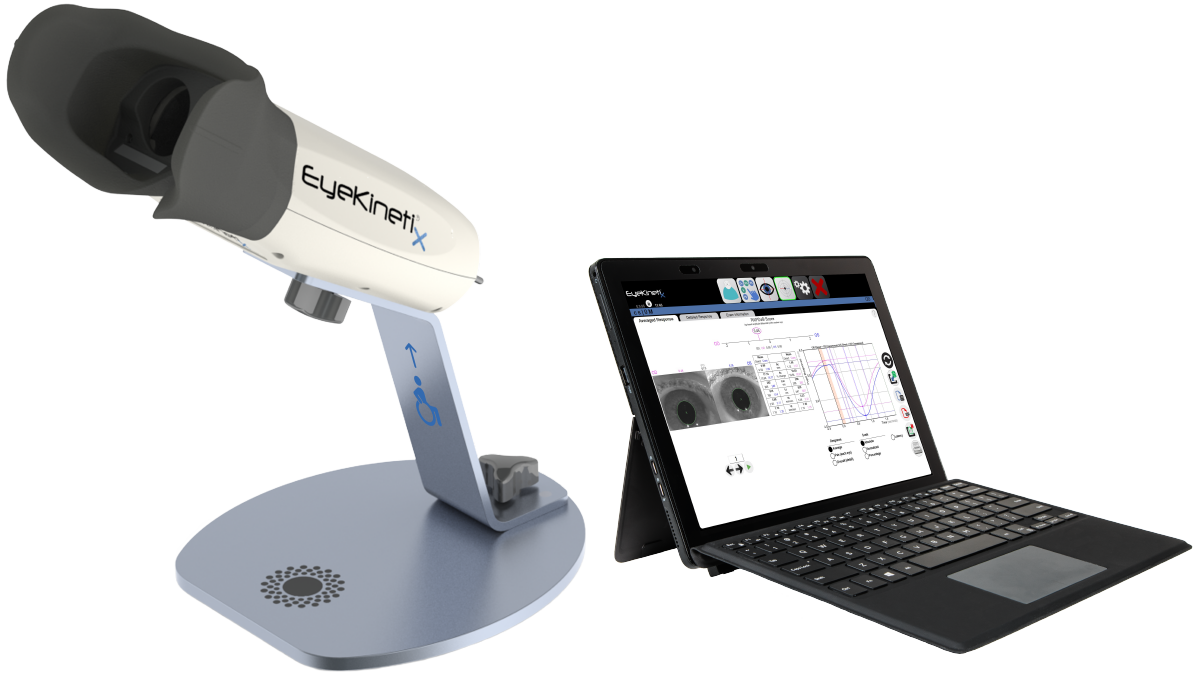
Coincidence you contacted me today, as this same day I detected new open angle glaucoma in a 28 year lady in for regular eye exam. She has 20/20 vision without glasses and has an exam once every 5 years. Without my RAPDx this glaucoma could have easily slipped by and she would suffer 5 more years of retinal nerve damage.
The RAPDx/EyeKinetix is truly amazing technology. It has saved the sight of numerous patients and build my glaucoma practice along the way.
Glen R. Owen, OD, FAAO
Edmonds Eyecare Associates, WA

The RAPDx score provides a highly sensitive and specific assessment of the RAPD as tested by the swinging flashlight method. It is easily used by ancillary personnel as part of the screening of patients and is a powerful tool for clinicians needing to identify, confirm and quantify Relative Afferent Pupillary Defects.
Nicholas J. Volpe, MD
Chairman, Department of Ophthalmology,
Northwestern University, Feinberg School of Medicine

I have diagnosed over a dozen patients with low-tension glaucoma with RAPDx. These patients had a relative afferent pupillary defect as their initial abnormal finding and without the benefit of automated objective pupillography, my index-of-suspicion for ocular disease would have been lower and I might have missed the diagnosis.
Craig Thomas, OD
First Eye Care Southwest Dallas, Tx

RAPDx is beneficial in my practice to easily and precisely quantify afferent pupillary abnormalities as well as accurate and quantitative documentation of follow-up progress in patients with diseases of the anterior visual pathways. In addition, RAPDx helps me detect subtle RAPDs in the early diagnosis of diseases, such as glaucoma, and to document the absence of an RAPD in non-organic, unilateral, vision loss.
Swaraj Bose, MD
Neuro-Ophthalmology & Orbit

The EyeKinetix provides peace of mind that our patient’s pupillary reflexes are being evaluated accurately and objectively. I have found the unit to be so much faster than its predecessor, RAPDx, and much more user/operator friendly. With the speed of EyeKinetix we do not have a bottle neck at our testing stations – it allows us to maintain the preliminary testing production flow.
This instrument is going to help us save someone’s life, or quality of life, by picking up subtle APD producing pathology—that we probably were going to miss. I believe in the unit so much that I have ordered 2 of them for our office.
Mario Gutierrez, OD, FAAO
The biggest problem with RAPD testing is that eyecare providers don’t do it … I estimate that pupillary testing is documented only about 10% of the time. It used to be gonioscopy took the prize for being done seldom and badly …”
Lankaranian, Spaeth et al 2007
Clinical Resources
Effects of Age and Sex on Values Obtained by RAPDx® Pupillometer, and Determined the Standard Values for Detecting Relative Afferent Pupillary Defect
Satou, Tsukasa, et al. "Effects of age and sex on values obtained by RAPDx® pupillometer, and determined the standard values for detecting relative afferent pupillary defect." Translational Vision Science & Technology 5.2 (2016): 18-18.
Correlation Between Inter-Eye Difference in Average Retinal Nerve Fiber Layer Thickness and Afferent Pupillary Response as Measured by an Automated Pupillometer in Glaucoma
Sarezky, Daniel, et al. "Correlation between inter-eye difference in average retinal nerve fiber layer thickness and afferent pupillary response as measured by an automated pupillometer in glaucoma." Journal of Glaucoma 25.3 (2016): 312-316.
Correlation Between Intereye Difference in Visual Field Mean Deviation Values and Relative Afferent Pupillary Response as Measured by an Automated Pupillometer in Subjects with Glaucoma
Sarezky, Daniel, et al. "Correlation between intereye difference in visual field mean deviation values and relative afferent pupillary response as measured by an automated pupillometer in subjects with glaucoma." Journal of Glaucoma 23.7 (2014): 419-423.
Pupil-based detection of asymmetric glaucomatous damage – comparison of the Konan RAPDx pupillograph, swinging flashlight method, and magnifier-assisted swinging flashlight method
Ali, Mohsin, et al. "Pupil-based detection of asymmetric glaucomatous damage-comparison of the Konan RAPDx pupillograph, swinging flashlight method, and magnifier-assisted swinging flashlight method." Investigative Ophthalmology & Visual Science 54.15 (2013): 4811-4811.
READ FULL ARTICLESymmetry of the pupillary light reflex and its relationship to retinal nerve fiber layer thickness and visual field defect
Chang, Dolly S., et al. "Symmetry of the pupillary light reflex and its relationship to retinal nerve fiber layer thickness and visual field defect." Investigative ophthalmology & visual science 54.8 (2013): 5596-5601.
Accuracy of pupil assessment for the detection of glaucoma: a systematic review and meta-analysis
Chang, Dolly S., et al. "Accuracy of pupil assessment for the detection of glaucoma: a systematic review and meta-analysis." Ophthalmology 120.11 (2013): 2217-2225.
READ FULL ARTICLEA novel computerized portable pupillometer detects and quantifies relative afferent pupillary defects
Cohen, Liza M., et al. "A novel computerized portable pupillometer detects and quantifies relative afferent pupillary defects." Current eye research 40.11 (2015): 1120-1127.
READ FULL ARTICLEEstimation of Retinal Ganglion Cell Loss in Glaucomatous Eyes With a Relative Afferent Pupillary Defect
Tatham, Andrew J., et al. "Estimation of retinal ganglion cell loss in glaucomatous eyes with a relative afferent pupillary defect." Investigative Ophthalmology & Visual Science 55.1 (2014): 513-522.
READ FULL ARTICLEUnilateral periodic pupillary constriction causing alternating anisocoria
Conrad, Erin C., et al. "Unilateral periodic pupillary constriction causing alternating anisocoria." Neurology 90.2 (2018): 86-88.
READ FULL ARTICLEDetecting glaucoma using automated pupillography
Tatham, Andrew J., et al. "Detecting glaucoma using automated pupillography." Ophthalmology 121.6 (2014): 1185-1193.
READ FULL ARTICLEDetecting Glaucoma with Pupillography
Chang, Dolly S., et al. "Detecting Glaucoma with Pupillography." Investigative Ophthalmology & Visual Science 53.14 (2012): 5621-5621.
READ FULL ARTICLEPupillographic evaluation of relative afferent pupillary defect in glaucoma patients
Ozeki, Naoki, et al. "Pupillographic evaluation of relative afferent pupillary defect in glaucoma patients." British Journal of Ophthalmology 97.12 (2013): 1538-1542.
READ FULL ARTICLE
